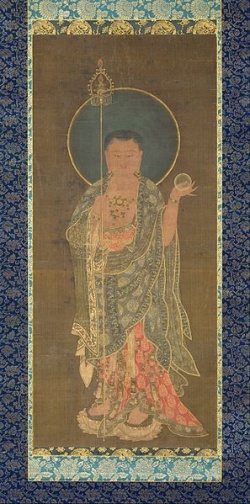Cintamani
Cintāmaṇi (Sanskrit; Devanagari: चिन्तामणि) also spelled as Chintamani (or the Chintamani Stone) is a wish-fulfilling jewel within both Hindu and Buddhist traditions, equivalent to the philosopher's stone (Paras Pathar) in Western alchemy.
In Buddhism it is held by the bodhisattvas, Avalokiteshvara and Ksitigarbha. It is also seen carried upon the back of the Lung ta (wind horse) which is depicted on Tibetan prayer flags. By reciting the Dharani of Cintamani, Buddhist tradition maintains that one attains the Wisdom of Buddha, able to understand the truth of the Buddha, and turn afflictions into Bodhi. It is said to allow one to see the Holy Retinue of Amitabha and assembly upon one's deathbed. In Tibetan Buddhist tradition the Chintamani is sometimes depicted as a luminous pearl and is in the possession of several of different forms of the Buddha.
Within Hinduism it is connected with the gods, Vishnu and Ganesha. In Hindu tradition it is often depicted as a fabulous jewel in the possession of the Naga king or as on the forehead of the Makara. The Yoga Vasistha, originally written in the 10th century AD, contains a story about the cintamani.
Nomenclature, orthography and etymology
- Cintāmaṇi (Sanskrit; Devanagari: चिन्तामणि): 'Wish-Fulfilling Gem' (Tibetan: ཡིད་བཞིན་ནོརྦུ, Wylie: yid bzhin norbu)
- The mani (jewel) is translated in Chinese ruyi or ruyizhu 如意珠 "as one wishes jewel" or ruyibaozhu 如意寶珠 "as one wishes precious jewel", and is pronounced in Japanese nyoi-hōju or nyoi-hōshu 如意宝珠.
History
In Buddhism the Chintamani is said to be one of four relics that came in a chest that fell from the sky (many terma fell from the sky in caskets) during the reign of king Lha Thothori Nyantsen of Tibet. Though the king did not understand the purpose of the objects, he kept them in a position of reverence. Several years later, two mysterious strangers appeared at the court of the king, explaining the four relics, which included the Buddha's bowl (possibly a Singing Bowl) and a mani stone with the Om Mani Padme Hum mantra inscribed on it. These few objects were the bringers of the Dharma to Tibet.
The Digital Dictionary of Buddhism's ruyizhu entry says:
- A maṇi-jewel; magical jewel, which manifests whatever one wishes for (Skt. maṇi, cintā-maṇi, cintāmaṇi-ratna). According to one's desires, treasures, clothing and food can be manifested, while sickness and suffering can be removed, water can be purified, etc. It is a metaphor for the teachings and virtues of the Buddha. … Said to be obtained from the dragon-king of the sea, or the head of the great fish, Makara, or the relics of a Buddha.
The Kintamani mountainous region in Bali was named after the Cintamani.
Popular culture
The Cintamani Stone is the subject of Dragon Ball and Uncharted 2: Among Thieves. In the former, the concept is used as seven mystical orbs known as Dragon Balls which when gathered together summon an Eternal Dragon capable of granting almost any wish, making them the target of several villains who desire eternal life or power over the universe. In the latter, it is revealed that it is not in fact a jewel but amber, fossilized resin from the Tree of Life which grants nigh invulnerability to those who use it, but at a terrible price, it turns the users into brutish, blue, simple-minded savages after long term exposure.
